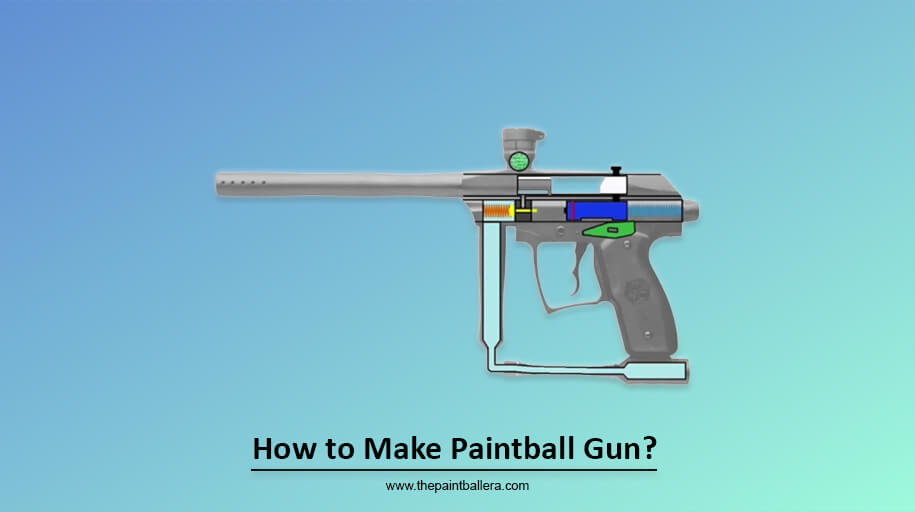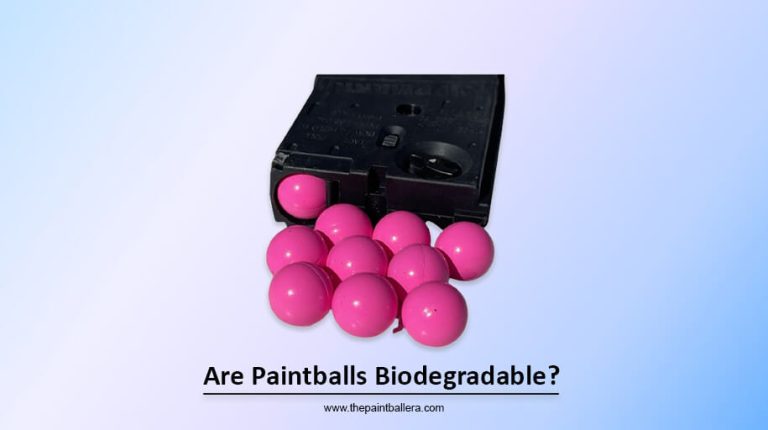How to Make Paintball Gun?

Hey there, paintball enthusiasts! I get it; paintball is not just a game; it’s a lifestyle. Whether you’re new to paintball or a seasoned vet, have you ever wondered how to make a paintball gun from scratch? While it’s convenient to buy one, there’s something uniquely satisfying about crafting your own.
Plus, it gives you the chance to truly understand your weapon, not to mention the bragging rights you’ll earn among your pals. This comprehensive guide will dive into the ins and outs of making your paintball gun. So, buckle up and let’s get started!
Stay tuned as we delve into the intricacies of paintball gun design, break down its parts like the firing system, feed system, and barrel, and then shift gears to the accessories that can take your game to the next level.
And, of course, we’ll walk you through the step-by-step process of building your DIY paintball gun. Let’s make sure the next time you step onto that field, it’s with a piece of equipment that you’ve tailored to perfection.
Paintball Gun Design
Creating a paintball gun is like a mini engineering project. But don’t worry, you don’t need to be a rocket scientist to get this right. What’s crucial here is understanding the basics—once you’ve got that, the rest is pretty much a breeze.
A paintball gun, also known as a paintball marker, usually consists of a simple mechanism that propels a paintball pellet using compressed air or CO2. The design might look complex, but it’s all about a controlled burst of gas pushing the paintball out of a barrel. It’s like how a slingshot works, just more modern.
The design part is super exciting, mainly because this is where you can let your creativity run wild. You can use a simple tube-and-trigger model or jazz it up with advanced features like electronic firing systems. The sky’s the limit—or, in this case, maybe it’s the range of your paintball gun!
Parts of the Paintball Gun
Alright, let’s roll up those sleeves and get down to business. To build your paintball gun, you must know its essential components. These are generally divided into three primary sections: the firing system, the feed system, and the barrel. Each serves its unique function, and they all work in tandem to ensure your paintball flies true.
1. Firing System
The firing system is the heart of your paintball gun. This is where the magic happens: compressed air or CO2 is released to propel the paintball.
This usually involves a trigger mechanism that releases compressed gas when pulled. Understanding the firing system is crucial because you’ve just got a fancy-looking stick without it.
2. Feed System
The feed system keeps your paintballs lined up and ready to go. You don’t want to be in the heat of a match, pull the trigger, and find out you’re shooting blanks, suitable? The feed system typically consists of a hopper that holds the paintballs and feeds them into the firing chamber when you’re ready to make that perfect shot.
3. Barrel
Last but not least, we’ve got the barrel. This long, usually cylindrical part directs the paintball on its trajectory. A well-designed barrel can significantly affect how accurate your shots are. So make sure to take advantage of this part!
Are you feeling pumped? I hope so! Understanding these essential components will pave the way for a smooth building process. And trust me, the sense of accomplishment you’ll feel when you fire that first shot from your DIY paintball gun will make all the effort worthwhile.
Paintball Accessories To Consider For Your Gun
Before you get completely absorbed in crafting your paintball gun, let’s talk about some extras that can elevate your paintball experience. Accessories can take your game from “Hey, this is fun!” to “Wow, I didn’t know paintball could be this amazing!”
1. Scopes/Sights: If accuracy is your game, consider attaching a scope or sight to your gun. These come in various styles and functionalities, from simple red dot sights to more complex optical contents.
2. Grips: A comfortable grip can make a difference when you’re on the field for extended periods. They offer better control less fatigue, and can even improve your aim.
3. Extended Hoppers: Running out of paintballs in the middle of an action-packed game is the worst. An extended hopper increases your ammo capacity so you can stay in the game longer.
4. Air Tanks: Consider an extra air tank or upgrade. More air means more shots, simple as that.
5. Protective Gear: Although not directly attached to your gun, always appreciate the importance of quality protective gear. Gloves, knee pads, and a reliable mask can make your paintball outing much more enjoyable.
How does a paintball gun work?
Now that you’re familiar with the parts and some nifty accessories, you might wonder, “Okay, but how does a paintball gun work?” Great question!
When you pull the trigger, a small burst of compressed air or CO2 is released from the tank into the firing system. This air pushes a paintball from the feed system into the barrel. The air expands, propelling the paintball out of the barrel and toward your target. It’s a well-timed sequence of events, much like a choreographed dance, but with more splatter.
Understanding this basic principle is crucial, as it’ll guide you through the building process. Knowing how each part interacts will make it easier to troubleshoot issues or make tweaks for better performance. It’s all about that perfect shot, after all.
So there you have it! You’re well on your way to becoming a paintball gunsmith. I can already feel your excitement bubbling over. Next, we’ll dive into the step-by-step guide on making your paintball gun.
Steps to Make Paintball Gun
1. Making the Gun
Okay, friends, here we are—the moment we’ve been waiting for. It’s time to roll up those sleeves a bit higher and dive into the actual making of the paintball gun.
By now, you should understand what goes into a paintball gun and how it works. Now, let’s bring that knowledge to life.
2. Using Your Paintball Gun
But wait, before we do, a quick note on using your DIY paintball gun: Always prioritize safety. Test the gun in a controlled environment away from people and pets.
Once you’re confident it works well, take it to a proper paintball field and enjoy the fruit of your labor with your buddies. It’ll be the talk of the day, I promise!
3. Gather Materials
First things first, let’s gather all the materials you’ll need. This includes PVC pipes for the barrel and body, a ball valve, some end caps, and a source of compressed air or CO2. A quick trip to your local hardware store should sort you out.
4. Build It
With everything ready, cut the PVC pipes to the desired length for your barrel and body. Once that’s done, attach the end caps to one end of each tube. This will serve as the chamber that holds the compressed air or CO2.
5.Start cementing
Now, it’s time to make things permanent. Use PVC cement to secure all the parts together. This is a crucial step; you want to ensure everything is air-tight, or you’ll lose pressure and performance.
THE OTHER PIECE
Remember the other piece of pipe that will act as the barrel. This is where your paintball will exit, so ensure it’s the suitable diameter for your paintballs. Attach this to the ball valve using more PVC cement.
CONNECT THE TWO
It’s time to connect the two main sections. Attach the ball valve to the body of your paintball gun, again using PVC cement to ensure a secure, air-tight fit.
CONNECT THE BALL VALVE AND BARREL
Lastly, connect the ball valve to the barrel. Turn the valve to the open position, and you’re ready. Load a paintball into the barrel, close the valve, connect your compressed air source, aim, and fire!
Conclusion
Phew, what a journey, right? We’ve gone from understanding how to make a paintball gun, dissecting its various parts, talking about some killer accessories, and finally, walking through the steps to build one yourself.
It’s been quite a ride, and I hope you’ve found this guide informative and inspiring. Nothing can replicate the joy and satisfaction of using something you’ve built with your hands, mainly when it performs beautifully in a paintball match.




![Can you go Paintballing while Pregnant? – [Safety Alert]](https://thepaintballera.com/wp-content/uploads/2023/08/Can-You-Go-Paintballing-While-Pregnant-768x430.jpg)

